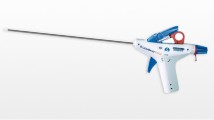Summary
Introduction
Laparoscopic procedures in groin hernia repair have been established since many years. Adhesive techniques for mesh fixation in the transabdominal pre-peritoneal (TAPP) procedure are now being increasingly discussed. Currently, there are three categories of adhesives available: synthetic adhesives (cyanoacrylate), biological products (e.g. fibrin glue) and genetically produced polymer protein adhesives.
The objective of this observation study was to evaluate the adhesive technique for mesh fixation and peritoneal closure using n-butyl-cyanoacrylate.
Material and method
Between January and February 2015, 20 consecutive male patients underwent TAPP surgery with mesh fixation and peritoneal closure with cyanoacrylate. The investigations encompassed complication rate and postoperative pain after 6 days and 3 months.
Results
Postoperative complication rate was low, one haematoma and one bulging. According to a standardised visual analogue scale (VAS 0–10), the average preoperative pain score was 2.8 (0–7), 1.2 (0–3) after 6 days and 0.1 (0–2) after 3 months. The mean operation time was 69 min. No hernia recurrence was detected during follow-up.
Conclusion
Our initial experience shows that mesh fixation and peritoneal closure using n-butyl-2-cyanoacrylate is save and sufficient.









Similar content being viewed by others
References
Matthews RD, Neumayer L. Inguinal hernia in the 21st century: an evidence-based review. Curr Probl Surg. 2008;45:261–312.
Primatesta P, Goldacre MJ. Inguinal hernia repair: incidence of elective and emergency surgery, readmission and mortality. Int J Epidemiol. 1996;25:835–9.
Katkhouda N, Mavor E, Friedlander MH, et al. Use of fibrin sealant for prosthetic mesh fixation in laparoscopic extraperitoneal inguinal hernia repair. Ann Surg. 2001;233:18–25.
Sajid MS, Ladwa N, Kalra L, et al. A meta-analysis examining the use of tacker fixation versus no-fixation of mesh in laparoscopic inguinal hernia repair. Int J Surg. 2012;10:224–31.
Bittner R, Montgomery MA, Arregui E, et al. Update of guidelines on laparoscopic (TAPP) and endoscopic (TEP) treatment of inguinal hernia (international endohernia society). Surg Endosc. 2015;29:289–321.
Fortelny RH, Petter-Puchner AH, Glaser KS, et al. Use of fibrin sealant (Tisseel/Tissucol) in hernia repair: a systematic review. Surg Endosc. 2012;26:1803–12.
Campanelli G, Pascual MH, Hoeferlin A, et al. Randomized, controlled, blinded trial of Tisseel/Tissucol for mesh fixation in patients undergoing Lichtenstein technique for primary inguinal hernia repair: results of the TIMELI trial. Ann Surg. 2012;255:650–7.
Matthews RD, Neumayer L. Inguinal hernia in the 21st century: an evidence-based review. Curr Probl Surg. 2008;45:261–312.
Petter-Puchner AH, Brunner W, Gruber-Blum S, et al. A systemic review of hernia surgery in SIL (single-incision laparoscopy) technique. Eur Surg. 2014;46:113–7.
Fischer S, Zechmeister-Koss I. Is day surgery safe? A systematic literature review. Eur Surg. 2014;46:103–12.
Topart P, Vandenbroucke F, Lozac’h P. Tisseel versus tack staples as mesh fixation in totally extraperitoneal laparoscopic repair of groin hernias: a retrospective analysis. Surg Endosc. 2005;19:724–7.
Lau H. Fibrin sealant versus mechanical stapling for mesh fixation during endoscopic extraperitoneal inguinal hernioplasty. Ann Surg. 2005;242:670–5.
Aasvang EK, Møhl B, Bay-Nielsen M, et al. Pain related sexual dysfunction after inguinal herniorrhaphy. Pain. 2006;122:258–63.
Burcharth J, Andresen K, Pommergaard HC, et al. Direct inguinal hernia and anterior surgical approach are risk factors for female inguinal hernia recurrences. Langenbecks Arch Surg. 2014;399:71–6.
Helvind NM, Andresen K, Rosenberg J. Lower reoperation rates with the use of fibrin sealant versus tacks for mesh fixation. Surg Endosc. 2013;27:4184–91.
Vakalopoulos KA, Daams F, Wu Z, et al. Tissue adhesives in gastrointestinal anastomosis: a systematic review. J Surg Res. 2013;180:290–300.
Duarte AP, Coelho JF, Bordado JC, et al. Surgical adhesives: systematic review of the main types and development forecast. Prog Polym Sci. 2012;37:1031–50.
Lodi D, Iannitti T, Palmieri B. Management of haemostasis in surgery: sealant and glue applications. Blood Coagul Fibrinolysis. 2012;23:465–72.
Lee MGM, Jones D. Applications of fibrin sealant in surgery. Surg Innov. 2005;12:203–13.
Ryou M, Thompson CC. Tissue adhesives: a review. Tech Gastrointest Endosc. 2006;8:33–7.
ASGE Technology Committee; Bhat YM, Banerjee S et al. Tissue adhesives: cyanoacrylate glue and fibrin sealant. Gastrointest Endosc. 2013;78:209–15.
Bay-Nielsen M, Thomsen H, Andersen FH, Bendix JH, Sorensen OK, Skovgaard N, Kehlet H. Convalescence after inguinal herniorrhaphy. Br J Surg. 2004;91:362–7.
Pavlin DJ, Chen C, Penaloza DA, Polissar NL, Buckley FP. Pain as a factor complicating recovery and discharge after ambulatory surgery. Anesth Analg. 2002;95:627–34.
Callesen T, Klarskov B, Bech K, Kehlet H. Short convalescence after inguinal herniorrhaphy with standardised recommendations: duration and reasons for delayed return to work. Eur J Surg. 1999;165:236–41.
Kehlet H, Jensen TS, Woolf CJ. Persistent postsurgical pain: risk factors and prevention. Lancet. 2006;367:1618–25.
McCormack K, Wake B, Perez J, Fraser C, Cook J, McIntosh E, Vale L, Grant A. Laparoscopic surgery for inguinal hernia repair: systematic review of effectiveness and economic evaluation. Health Technol Assess. (2005);9:1–203, iii–iv.
Cuschieri A. Tissue adhesives in endosurgery. Semin Laparosc Surg. 2001;8:63–8.
Jourdan IC, Bailey ME. Initial experience with the use of N-butyl-2-cyanoacrylate glue for the fixation of polypropylene mesh in laparoscopic hernia repair. Surg Laparosc Endosc. 1998;8:291–3.
Fortelny RH, Pettert-Puchner AH, Walder N, Mittermayr R, Öhlinger W, Heinze A, Redl H. Cyanoacrylate tissue sealant impairs tissue integration of macroporous mesh in experimental hernia repair. Surg Endosc. 2007;21:1781–5.
Fortelny RH, Petter-Puchner AH, May C, Jaksch W, Benesch T, Khakpour Z, Redl H, Glaser KS. The impact of a traumatic fibrin sealant vs. staple mesh fixation in TAPP hernia repair on chronic pain and quality of life: results of a randomized controlled study. Surg Endosc. 2012;26:249–54.
Kukleta JF, Freytag C, Weber M, et al. Efficiency and safety of mesh fixation in laparoscopic inguinal hernia repair using n-butyl-cyanoacrylate: long-term biocompatibility in over 1300 mesh fixations. Hernia. 2012;16:153–62.
Author information
Authors and Affiliations
Corresponding author
Rights and permissions
About this article
Cite this article
Mittermair, R., Jenic, G., Kolenik, R. et al. TAPP surgery with mesh fixation and peritoneal closure using n-butyl-2-cyanoacrylate (LiquiBand®FIX8TM)—initial experience. Eur Surg 48, 110–114 (2016). https://doi.org/10.1007/s10353-015-0367-z
Received:
Accepted:
Published:
Issue Date:
DOI: https://doi.org/10.1007/s10353-015-0367-z




